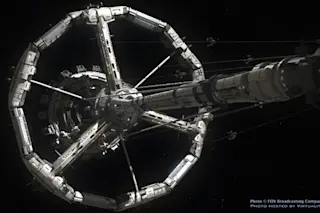Pixar worked its magic this weekend, shooting to the top of the box office for the ninth consecutive time with WALL-E. And deservedly so--the movie pulls you into its world, and anybody whose heart doesn't go out to the title character has a soul made of burnt toast. WALL-E is the name of the last robot left cleaning up the garbage-strewn Earth. All the humans left for an intergalactic cruise while the planet was getting spruced up, but the cruise has been going on for 700 years now with no end in sight. Used to being pampered by robots and never leaving their hover-chairs, the humans have gotten a little bit portly over the centuries, and now find it difficult to even walk (if it ever occured to them to do so). Which is a problem that lurks in the minds of the people who are planning real-life expeditions to ...
WALL-E’s Right: The Next Small Step Might Be A Tough One
Discover how the WALL-E movie reveals challenges facing humans in space, including muscle and bone loss in zero-gravity environments.
More on Discover
Stay Curious
SubscribeTo The Magazine
Save up to 40% off the cover price when you subscribe to Discover magazine.
Subscribe



